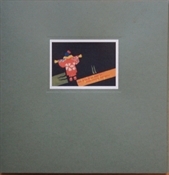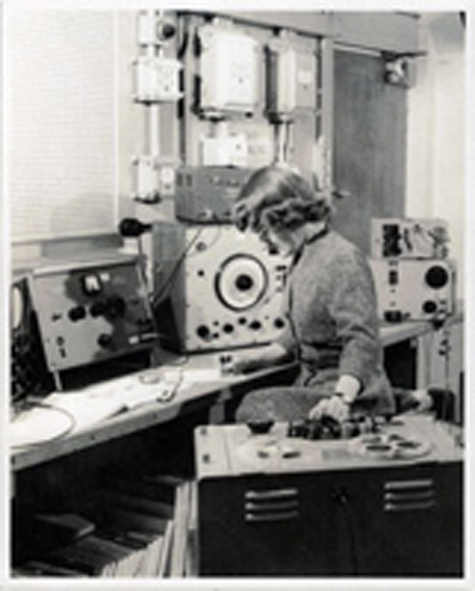 This has got to be one of the most improbable, altruistic, and quixotic box sets ever produced, as it compiles 12 albums worth of almost entirely unreleased material from Oliveros' fertile early years.  That, of course, means: 1.) none of her early masterpieces like "Bye Bye Butterfly" are here, and 2.) nothing at all is included from the wildly different (and superior) work that she has done over the last four decades.  Those caveats, coupled with the inarguable fact that no artist on earth has a dozen killer albums worth of vault material lying around, makes this a pretty undesirable prospect for the merely curious or for anyone looking for a definitive retrospective.  For serious fans of early electronic music, however, this is an absolute goldmine.
This has got to be one of the most improbable, altruistic, and quixotic box sets ever produced, as it compiles 12 albums worth of almost entirely unreleased material from Oliveros' fertile early years.  That, of course, means: 1.) none of her early masterpieces like "Bye Bye Butterfly" are here, and 2.) nothing at all is included from the wildly different (and superior) work that she has done over the last four decades.  Those caveats, coupled with the inarguable fact that no artist on earth has a dozen killer albums worth of vault material lying around, makes this a pretty undesirable prospect for the merely curious or for anyone looking for a definitive retrospective.  For serious fans of early electronic music, however, this is an absolute goldmine.
Two new shows just for you. We have squeezed out two extended release episodes for this weekend to get you through this week. They contain mostly new songs but there's also new issues from the vaults. The first show features music from Rider/Horse, Mint Field, Robert Aiki Aubrey Lowe, Anastasia Coope, ISAN, Stone Music, La Securite, Bark Psychosis, Jon Rose, Master Wilburn Burchette, Umberto, Wand, Tim Koh, Sun An, and Memory Drawings. The second episode has music by Laibach, Melt-Banana, Chuck Johnson, X, K. Yoshimatsu, Dorothy Carter, Pavel Milyakov, Violence Gratuite, Mark Templeton, Dummy, Endon, body / negative, Midwife, Alberto Boccardi, Divine. Cow in Maui from Veronika in Vienna. Get involved: subscribe, review, rate, share with your friends, send images! |



 Pauline Oliveros' best-known and influential work is 1989's Deep Listening, recorded in a massive, reverberant cistern.  In the years since that landmark effort, Pauline has founded The Deep Listening Institute, the Deep Listening Band, and performed many mesmerizing concerts in her unending crusade to explore the untapped potential of space, place, and (of course) reverberation.  These two previously unreleased albums capture some of the final recordings her band made with (the late) long-term collaborator/pianist/electronics wizard David Gamper. Although both performances occurred over the course of a January 2011 Seattle residency, they almost sound like two completely different bands: Octagonal Polyphony luxuriates in sublime, slow-motion drones while Great Howl becomes pretty nerve-jangling.
Pauline Oliveros' best-known and influential work is 1989's Deep Listening, recorded in a massive, reverberant cistern.  In the years since that landmark effort, Pauline has founded The Deep Listening Institute, the Deep Listening Band, and performed many mesmerizing concerts in her unending crusade to explore the untapped potential of space, place, and (of course) reverberation.  These two previously unreleased albums capture some of the final recordings her band made with (the late) long-term collaborator/pianist/electronics wizard David Gamper. Although both performances occurred over the course of a January 2011 Seattle residency, they almost sound like two completely different bands: Octagonal Polyphony luxuriates in sublime, slow-motion drones while Great Howl becomes pretty nerve-jangling. Named after the groundbreaking 1926 film by Kenji Mizoguchi, this collaboration opens with a very familiar sound found in the first two Vikki Jackman albums: Vikki on piano. Once again it is a slow, delicate, and serene melody, but it is brief and a quite deceptive introduction to the album, conceptually. There is very little of the bright piano as the record unfolds.
Named after the groundbreaking 1926 film by Kenji Mizoguchi, this collaboration opens with a very familiar sound found in the first two Vikki Jackman albums: Vikki on piano. Once again it is a slow, delicate, and serene melody, but it is brief and a quite deceptive introduction to the album, conceptually. There is very little of the bright piano as the record unfolds. An enigmatic project out of the wilds of Madison, Wisconsin, this duo, with connections to the likes of Kinit Her, Burial Hex, and many more projects, weave together an unlikely combination of medieval folk, post-rock, and electronic sounds into two side-long pieces that channel a variety of moods, though most of them are cast with some level of darkness.
An enigmatic project out of the wilds of Madison, Wisconsin, this duo, with connections to the likes of Kinit Her, Burial Hex, and many more projects, weave together an unlikely combination of medieval folk, post-rock, and electronic sounds into two side-long pieces that channel a variety of moods, though most of them are cast with some level of darkness. The subharcord is an early electronic instrument designed in East Germany during the 1960s. Essentially a subharmonic sound generator, its main function was to be a sound effects generator for TV and film. Only three of the original eight machines are thought to exist, and Bretschneider used one of them in June of 2007 (later remixed and edited in 2011) to create the material that makes up this single piece, a multifaceted composition that stays compelling throughout its entire 37-minute duration.
The subharcord is an early electronic instrument designed in East Germany during the 1960s. Essentially a subharmonic sound generator, its main function was to be a sound effects generator for TV and film. Only three of the original eight machines are thought to exist, and Bretschneider used one of them in June of 2007 (later remixed and edited in 2011) to create the material that makes up this single piece, a multifaceted composition that stays compelling throughout its entire 37-minute duration. Originally released to raise money for recording the next Swans studio album, this live album has been repackaged and trimmed down for mass consumption. Capturing the group at one of its many peaks, it provides a thrilling document for those who paid witness or for those poor unfortunates who found themselves unable to attend any of the shows. A wide range of older classics, recent songs and new semi-improvised works make up the set list. If anyone still doubted the sincerity or legitimacy of the reformed Swans, this will silence all arguments.
Originally released to raise money for recording the next Swans studio album, this live album has been repackaged and trimmed down for mass consumption. Capturing the group at one of its many peaks, it provides a thrilling document for those who paid witness or for those poor unfortunates who found themselves unable to attend any of the shows. A wide range of older classics, recent songs and new semi-improvised works make up the set list. If anyone still doubted the sincerity or legitimacy of the reformed Swans, this will silence all arguments. Previously, Gregory Scharpen’s work as Thomas Carnacki has been strange in an unsettling way, finding haunted parts of the psyche and probing them relentlessly. For this latest album, the music retains its strangeness but now there is a fantastic, warm feeling running through the pieces. There remains a darkness lurking beneath the surface but Scharpen’s humor is more evident now than before.
Previously, Gregory Scharpen’s work as Thomas Carnacki has been strange in an unsettling way, finding haunted parts of the psyche and probing them relentlessly. For this latest album, the music retains its strangeness but now there is a fantastic, warm feeling running through the pieces. There remains a darkness lurking beneath the surface but Scharpen’s humor is more evident now than before. This debut release from Matt Harries as Brennendes Gehirn is a veritable storm of turbulent noises, ranging from freeform sketches to the kind of almost-danceable rhythms that I would expect from classic albums from Scorn. Bleakly psychedelic sounds reverberate and bump off each other like living creatures as Harries builds a magnificent range of pieces from the sort of junk sounds that can easily be boring or clichéd in less skilled hands.
This debut release from Matt Harries as Brennendes Gehirn is a veritable storm of turbulent noises, ranging from freeform sketches to the kind of almost-danceable rhythms that I would expect from classic albums from Scorn. Bleakly psychedelic sounds reverberate and bump off each other like living creatures as Harries builds a magnificent range of pieces from the sort of junk sounds that can easily be boring or clichéd in less skilled hands.
 The exquisitely curated 12k label has always had a diverse roster, but Gareth Dickson may be the most "out there" artist to be working with the label. In this case, it is because his acoustic guitar and vocal work is so much more along the lines of conventional singer-songwriter when placed aside the label's otherwise more electronic and abstract catalogue. However, Dickson's work has an understated complexity and depth that makes it a perfect fit for the label. And furthermore, this is another excellent work from this Scottish artist.
The exquisitely curated 12k label has always had a diverse roster, but Gareth Dickson may be the most "out there" artist to be working with the label. In this case, it is because his acoustic guitar and vocal work is so much more along the lines of conventional singer-songwriter when placed aside the label's otherwise more electronic and abstract catalogue. However, Dickson's work has an understated complexity and depth that makes it a perfect fit for the label. And furthermore, this is another excellent work from this Scottish artist.
